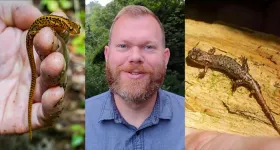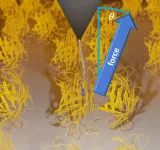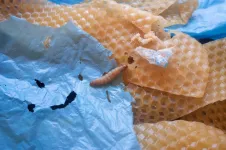(Press-News.org) Photos
For the first time, researchers have pinpointed a date when elite Mongol Empire people were drinking yak milk, according to a study co-led by a University of Michigan researcher.
By analyzing proteins found within ancient dental calculus, an international team of researchers provides direct evidence for consumption of milk from multiple ruminants, including yak. In addition, they discovered milk and blood proteins associated with both horses and ruminants. The team's results are published in Communication Biology.
The study presents novel protein findings from an elite Mongol Era cemetery with exceptional preservation in the permafrost. This is the first example of yak milk recovered from an archaeological context.
Previous research indicates that milk has been a critical resource in Mongolia for more than 5,000 years. While the consumption of cattle, sheep, goat and even horse milk have securely been dated, until now, when people began drinking milk from yaks has been difficult to determine. Understanding when and where humans domesticated this iconic species has been limited to rarely recovered yak remains and artistic depictions of yaks. However, whether these are wild or domestic is unclear.
The discovery of an elite Mongol era cemetery in northern Mongolia was surprising to the researchers.
"Our most important finding was an elite woman buried with a birchbark hat called a bogtog and silk robes depicting a golden five-clawed dragon. Our proteomic analyses concluded that she drank yak milk during her lifetime," said Alicia Ventresca-Miller, U-M assistant professor of anthropology. "This helped us verify the long-term use of this iconic animal in the region and its ties to elite rulers."
Located along a high-elevation ridgeline covered in mist, the location bears the name 'Khorig,' meaning taboo. It may be that this cemetery was considered elite, as the researchers recovered evidence of connections to the ruling elite, including a five-clawed dragon depicted on a Cizhou vessel and traditional robe, or deel.
"Ceramic vessels were turned into lanterns made of dairy products, which revealed long-standing religious ideas and the daily life of the elites of the Mongol empire," said J. Bayarsaikhan, a researcher at the Max Planck Institute for the Science of Human History and the National Museum of Mongolia.
Archaeologists have spent years collecting and conserving pieces of silk and leather strewn across the surface near the burials. Unfortunately, over the past few decades the permafrost has begun to melt and the sites have been heavily looted.
"The degree of looting that we are seeing is unprecedented. Nearly every burial that we can locate on the surface has recently been destroyed by looting activity," said Julia Clark of Nomad Science.
Archaeologists have long suspected that this area was important, and it remains one of the primary areas of yak herding in the present day. While much was lost to looters, what remained of the burials was still well preserved within the permafrost.
An international team of researchers used proteomic analysis of dental calculus to identify the diets of Mongol era elites. They found proteins associated with milk, blood and other tissues that had been consumed by different individuals.
"What is really exciting is that between cows and yaks, there is only a single difference in the amino acid sequence in the most commonly recovered milk protein, and in this case, we were able to recover the part which is specific to yak, Bos mutus," said study co-lead and palaeoproteomics specialist Shevan Wilkin of the University of Zurich and Max Planck Institute for the Science of Human History.
Due to the incredible preservation made possible through the permafrost environmental conditions, the team was able to identify intriguing proteins recovered for the first time from archaeological samples. These included horse milk curd proteins as well as caprine and equine blood proteins that had not been previously recovered from dental calculus.
Ventresca-Miller is also the director of Ancient Protein and Isotope Laboratory at U-M and a research affiliate at the Max Planck Institute for the Science of Human History.
Study: Permafrost preservation reveals proteomic evidence for yak milk consumption in the 13th century
END
Yak milk consumption among Mongol Empire elites
2023-03-31
ELSE PRESS RELEASES FROM THIS DATE:
Hope for salamanders? Illinois study recalibrates climate change effects
2023-03-31
URBANA, Ill. – For tiny salamanders squirming skin-to-soil, big-picture weather patterns may seem as far away as outer space. But for decades, scientists have mostly relied on free-air temperature data at large spatial scales to predict future salamander distributions under climate change. The outlook was dire for the mini ecosystem engineers, suggesting near elimination of habitat in crucial areas.
Now, University of Illinois researchers are tuning into the microclimates that really matter to the imperiled amphibians and forecasting a somewhat more hopeful future.
“The ...
Engineered E. coli delivers therapeutic nanobodies to the gut
2023-03-31
BOSTON-- Humans are colonized with thousands of bacterial strains. Researchers are now focused on genetically modifying such bacteria to enhance their intrinsic therapeutic properties.
One goal is to develop smart microbes that release therapeutic payloads at sites of disease, thus maintaining therapeutic efficacy while limiting many of the side effects that can be associated with the systemic administration of conventional drugs.
Investigators at Massachusetts General Hospital (MGH), a founding member of Mass General Brigham (MGB), have engineered a strain of the probiotic Escherichia ...
New type of friction discovered in ligand-protein systems
2023-03-31
An interdisciplinary research team of the Institutes of Physical Chemistry and Physics of the University of Freiburg and the Max Planck Institute of Biophysics in Frankfurt-am-Main has discovered a new, direction-dependent friction in proteins called anisotropic friction. “Until now, nobody had observed that friction in biomolecules was dependent on direction,” says physicist Dr. Steffen Wolf of the University of Freiburg. The results have been published as cover story in the scientific journal “Nano Letters.”
Experiments on model complex of protein-ligands
Proteins constitute the microscopic machinery of cells. They perform work during their functional cycles. Accordingly, ...
New UNC Chapel Hill study quantifies $562M in financial risk from Hurricane Florence using novel modeling approach that evaluates risk of mortgage default and property abandonment
2023-03-31
When Hurricane Florence made landfall on North Carolina’s coast in 2018, it brought record rainfall causing catastrophic flooding and damages to communities across the eastern portion of the state.
Estimating the financial impacts of household flooding is complex because direct damages often snowball into other financial risks, like a decrease in property value or loss of equity. Generally, post-disaster damage assessments focus on insured and uninsured losses, but these numbers do not account for the secondary impacts to households, lenders, local governments and other stakeholders who may also share in the financial consequences if a property owner defaults ...
What is foreign exchange market or simply Forex?
2023-03-31
The Forex market, also known as the foreign exchange market or simply Forex (short for "foreign exchange"), is a decentralized global market where various currencies are traded. It is the largest financial market in the world, with a daily trading volume exceeding $6 trillion. The primary purpose of the Forex market is to facilitate international trade and investment by allowing businesses, governments, and individuals to convert one currency into another.
Can cities make room for woodpeckers?
2023-03-31
Researchers are deploying the latest mapping techniques to identify the most important suburban habitat for North America’s largest woodpecker.
University of Cincinnati doctoral student Ruijia Hu said wildlife habitat in congested places like southwest Ohio is becoming increasingly fragmented as forests give way to new construction. Eventually, this could spell trouble to an animal with specific habitat needs like Ohio’s pileated woodpecker.
Pileated woodpeckers are crow-sized birds with colorful red crests and striking white facial stripes. They are found in forests from British Columbia to Florida. They have the ...
Study: ChatGPT has potential to help cirrhosis, liver cancer patients
2023-03-31
A new study by Cedars-Sinai investigators describes how ChatGPT, an artificial intelligence (AI) chatbot, may help improve health outcomes for patients with cirrhosis and liver cancer by providing easy-to-understand information about basic knowledge, lifestyle and treatments for these conditions.
The findings, published in the peer-reviewed journal Clinical and Molecular Hepatology, highlights the AI system’s potential to play a role in clinical practice.
“Patients with cirrhosis and/or liver cancer and their caregivers often have unmet needs and insufficient knowledge about managing and preventing complications of their disease,” ...
A healthy microbiome may prevent deadly infections in critically ill people
2023-03-31
Twenty to 50 per cent of all critically ill patients contract potentially deadly infections during their stay in the intensive care unit or in hospital after being in the ICU – markedly increasing the risk of death.
“Despite the use of antibiotics, hospital-acquired infections are a major clinical problem that persists to be a huge issue for which we don’t have good solutions,” says Dr. Braedon McDonald, MD, PhD, an intensive care physician at the Foothills Medical Centre (FMC) and assistant professor at the ...
Academic institutions receive lower financial returns from biotechnology licenses than commercial firms
2023-03-31
BENTLEY UNIVERSITY
The financial terms of biotechnology licenses from academic institutions are significantly less favorable than those of comparable licenses between commercial firms according to a new study from Bentley University’s Center for Integration of Science and Industry. The study, published in the journal PLOS ONE, shows that the royalties and payments to academic institutions are significantly lower than those to commercial firms for similar licenses and products at the same stages of development.
The article, titled “Comparing the economic terms of biotechnology licenses from academic institutions with those ...
Harnessing nature to promote planetary sustainability
2023-03-31
As Earth’s population grows, the demands of modern lifestyles place mounting strain on the global environment. Proposed solutions to preserve and promote planetary sustainability can sometimes prove more harmful than helpful. However, technologies that harness natural processes could be more successful.
Such technologies are the focus of the latest issue of the open access journal PLOS Biology, which features a special collection publishing March 31st of papers highlighting biology-based solutions that could be applied to reduce carbon dioxide emissions, eliminate non-degradable plastics, produce food or energy ...



